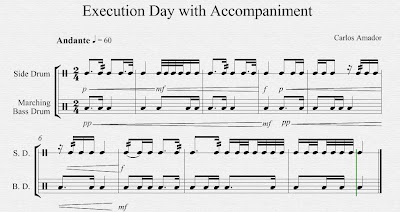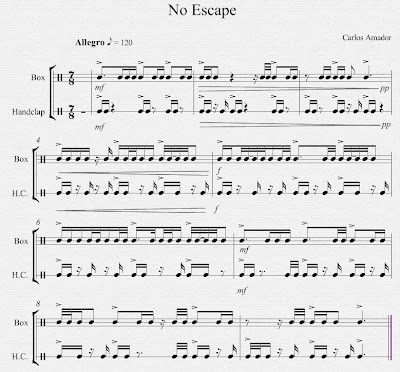Project 2: Duets
Tell me
This little duet explores a dialogue between two instruments, the side drum and the the Tenor drum. Because of the dialogue feature, I found easier to write both instruments for each bar as I was going along instead of writing the whole piece for one of them and fill gaps with the second instrument (I tried this but it didn’t work). I use a lot of up beat tempo for the tenor drum as it is interrupting the speech of the other instrument. In the first 2 bars, this happens in the first beat while in the next 2 bars this happens in the second beat. In Bars 5-6, both instruments alternate 1 beat each indicating that they are reaching to a agreement which happens in bar 7 when they basically play the same rhythm with one instrument filling the gaps of the other instrument.
Execution Day with Accompaniment
This is the piece I composed in the first project but in this case I have added a second percussion line that uses the tenor drum for accompaniment. The volume of this accompaniment line follows the main line but always slightly below.
Funny
This is a little composition where two instruments are used to play with a single melody. It uses a 5/8 metre. To reinforce the 3+2 time in the 5/8 metre, I use each instruments for durations of 1 or 3 quavers during the 3-quaver part and 1 or 2 quavers during the 2-quaver part. Therefore, a duration of 2 quavers with the colour of a single instrument is not allowed during the 3 quaver section (this keeps the music piece more symmetric and balanced). During the first 4 bars, the rattle and the ratchet pass ideas to each other and in most cases one of the instruments fills the silences of the other instrument creating a single melody. In the next 4 bars the rattle has a bit of a secondary role to end up in the last 4 bars where both instruments are protagonists with almost two phrases that complement each other.
No Escape
This piece has an ABA




No comments:
Post a Comment